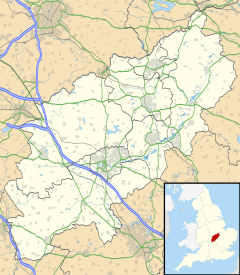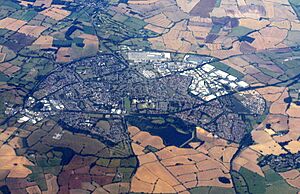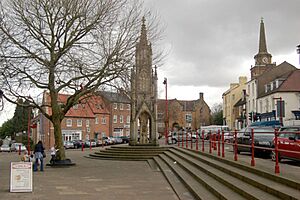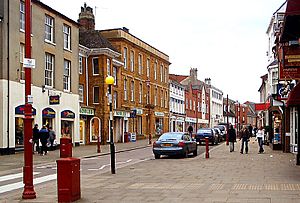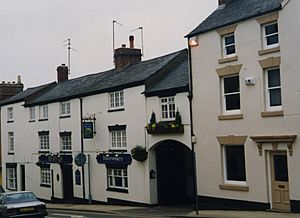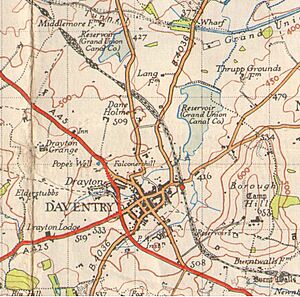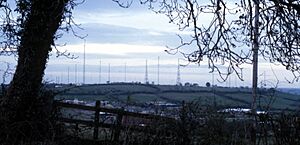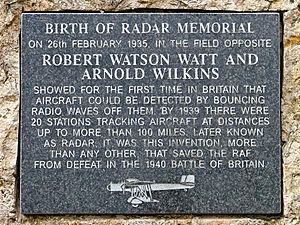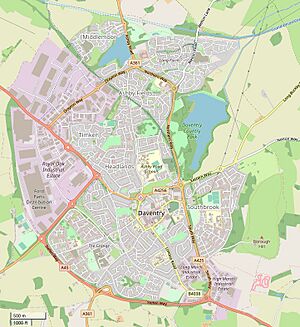Daventry facts for kids
Quick facts for kids Daventry |
|
|---|---|
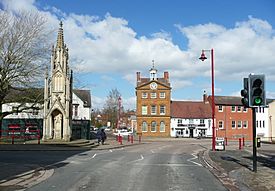 Daventry New Street, looking towards Market Square |
|
| Population | 28,123 (2021 Census) |
| OS grid reference | SP5762 |
| Civil parish |
|
| Unitary authority |
|
| Ceremonial county | |
| Region | |
| Country | England |
| Sovereign state | United Kingdom |
| Post town | DAVENTRY |
| Postcode district | NN11 |
| Dialling code | 01327 |
| Police | Northamptonshire |
| Fire | Northamptonshire |
| Ambulance | East Midlands |
| EU Parliament | East Midlands |
| UK Parliament |
|
Daventry (pronounced DAV-ən-tree) is a busy market town in Northamptonshire, England. It's part of the West Northamptonshire area and is quite close to the border with Warwickshire. In 2021, about 28,123 people lived in Daventry.
Contents
Where is Daventry Located?
Daventry is about 75 miles (120 km) north-west of London. It's also 14 miles (23 km) west of Northampton and about 10 miles (16 km) south-west of Rugby.
The town is located on a "watershed." This means that rain falling on one side of Daventry flows into the River Leam (which goes west). Rain on the other side flows into the River Nene (which goes east). There isn't a river right in the town. Instead, there are two large reservoirs. These were built to supply water to the Grand Union Canal. This canal passes north of Daventry through the long Braunston Tunnel.
The Watford Gap is about 4 miles (6 km) north-east of Daventry. This area is important because several major transport routes pass through it:
- The old Roman road, Watling Street.
- The Grand Union Canal.
- The West Coast Main Line railway.
- The M1 motorway.
Daventry has several modern housing areas. These include Drayton, Middlemore Farm, Lang Farm, and Monksmoor Park. The town is also twinned with Westerburg in Germany.
 |
Leicester Lutterworth Rugby |
 |
||
| Warwick, Leamington Spa, Southam | Northampton | |||
| Brackley Bicester |
What is Daventry Like?
The oldest part of Daventry is a special "conservation area." This means its historic buildings are protected. Most of these buildings were built between the 1600s and 1800s. Until the 1950s, Daventry was a small town with only about 4,000 people. All the big growth happened more recently. So, the old town centre is now surrounded by modern roads, houses, and business parks.
There are two lovely country parks near Daventry:
- The Daventry Country Park is north-east of the town centre. It's built around a canal reservoir.
- Borough Hill country park is on the south-eastern edge of town.
Many buildings in Daventry's centre are "listed buildings." This means they are important for their history or architecture. The most important is the Church of Holy Cross, built in the 1700s. Other important buildings include the Saracen's Head, the Moot Hall, and the Wheatsheaf.
A street market is held every Tuesday and Friday on High Street. There's also a modern shopping area called Bowen Square next to the High Street.
Some local people used to pronounce Daventry as 'Daintree', but this is not as common anymore.
Daventry's Past
Early History and Name Origins
Daventry is overlooked by Borough Hill, a 653-foot (199 m) high hill. People have lived on this hill for a very long time!
- Remains of Bronze Age burial mounds have been found.
- Two Iron Age hill forts were here. One is the fourth largest ever found in Britain.
- Later, a Roman villa and farm settlement were built on the hill.
The name Daventry might come from an old Anglo-Saxon name, "Dafa's tree." This suggests there was a special meeting tree, possibly on Borough Hill, belonging to a founding leader named Dafa. It's similar to how Coventry got its name ("Cofa's tree").
Medieval and Tudor Times
Daventry was first mentioned in the Domesday Book in 1086. It belonged to Countess Judith, who was William the Conqueror's niece.
Around 1108, a small monastery called Daventry Priory was founded. It was closed in 1526 by Cardinal Wolsey.
In 1203, a market was first recorded in Daventry. The town's location on a main road helped the market grow. This road connected Coventry with Watling Street, a major route from the Midlands to London.
In 1576, Daventry's grammar school was started by William Parker. The original school building from around 1600 is still standing today. In the same year, Queen Elizabeth I gave Daventry "borough status." This meant it had its own local government.
The famous writer William Shakespeare even mentioned Daventry in his play Henry IV, Part I. He would have known the town because it was close to his home, Stratford-upon-Avon, and on a main route to London.
English Civil War
During the English Civil War in 1645, King Charles I and his army stayed in Daventry. They camped on Borough Hill. The King stayed at the Wheatsheaf Inn.
Legend says that the ghost of King Charles's friend, Thomas Wentworth, visited him twice at the Wheatsheaf Inn. The ghost warned him not to fight.
However, the Parliament's army, led by Sir Thomas Fairfax, was also nearby. They clashed with the King's soldiers on June 12, 1645. This led to the important Battle of Naseby, where the King's army was defeated. Naseby village is about 14 miles (23 km) north-east of Daventry.
Coaching Town Era
In the 1700s and early 1800s, Daventry became a very busy "coaching town." This was because new and better roads were built, allowing mail coaches and passenger coaches to travel long distances. Daventry was on the main routes connecting London with the West Midlands and other important cities.
Many inns in Daventry welcomed travellers, like the Wheatsheaf and the Saracen's Head. At its busiest in the 1830s, over 250 coaches passed through Daventry every week! Many of the town's beautiful buildings, like the Holy Cross Church (built in 1758), were constructed during this time.
Decline and Revival (1838-1955)
The Industrial Revolution didn't help Daventry much. The new Grand Junction Canal (now Grand Union) opened in 1796, but it passed a few miles north of the town. A plan to build a canal branch to Daventry never happened.
Then, in 1838, the London and Birmingham Railway opened. This was the start of the railway age. The coaching business quickly declined, and Daventry went through a long period where it didn't grow much. Its population even went down until the 1950s.
A railway branch line to Daventry was finally built in 1888, connecting it to Weedon. This line was later extended to Leamington Spa. However, it was only a small branch line and didn't really help the town's economy much.
Broadcasting Station
In 1925, the BBC built a large radio transmitting station on Borough Hill. Daventry was chosen because it was a good spot to reach most of England and Wales. From 1932, the BBC Empire Service (now BBC World Service) broadcast from there. The famous announcement "Daventry calling" made the town known worldwide. The station helped Daventry's population grow as BBC staff moved to the area.
The station had 43 radio masts by 1990. It closed in 1992, and most of the masts were taken down. The land became a country park.
Birth of Radar
On February 26, 1935, a very important experiment happened using the Daventry radio transmitter. This was the first practical test of radar, invented by Robert Watson-Watt and Arnold Frederic Wilkins. They used a special receiver in a van to pick up radio signals that bounced off an airplane. This showed that it was possible to find the position of aircraft using radio waves.
This successful experiment led the British government to build a network of radar stations. These stations, called Chain Home, were very important for the RAF during the Battle of Britain in 1940.
In 2010, 75 years after the original experiment, amateur radio teams re-enacted the "Daventry Experiment." They successfully detected signals from aircraft, just like in 1935.
Daventry Since 1955
Daventry started to grow much faster from the mid-1950s. In 1955, a large factory for tapered roller bearings opened. The town also benefited when the M1 motorway opened nearby, connecting Daventry directly to London.
Even with this growth, Daventry railway station closed to passengers in 1958. The railway line itself closed in 1963.
Planned Expansion
In 1961, Daventry was chosen to help house people and businesses moving from Birmingham. This was part of a government plan to spread out population and industry. Even though Daventry wasn't officially a "New Town," its expansion was planned in a similar way.
Work on this expansion began in the late 1960s. Birmingham City Council bought land to build houses and business parks. Northamptonshire County Council provided roads and schools. Daventry provided drainage and sewage.
The first new housing area, the Southbrook Estate, started in 1966. By 1972, over 1,000 new families and many new businesses had moved to Daventry. However, growth slowed down in the mid-1970s. Birmingham City Council stopped its involvement in 1976.
Even so, Daventry's population nearly tripled between 1961 and 1981, growing from 5,860 to 16,178. Since then, growth has continued, mainly from private developments. By 2011, the population was 25,026.
Recent Events
In 1981, a small tornado hit Daventry. In 2006, the town's outdoor swimming pool, which had been built by residents, closed due to funding problems.
In March 2018, Daventry's High Street was used as a filming location for the movie Nativity Rocks!.
Important Buildings and Landmarks
- The Holy Cross Church is Daventry's main church. It was built between 1752 and 1758 and is made of local stone. It's the only 18th-century town church in Northamptonshire.
- The Moot Hall is on the Market Square. It was built in 1769 and has been used for many things, including the town council office, a museum, and a children's nursery.
- The Wheatsheaf Hotel is an old coaching inn from the early 1600s. King Charles I stayed here before the Battle of Naseby in 1645. It's now a nursing home.
- The former Daventry Grammar School on New Street dates back to 1600. It's one of the oldest buildings in town and is now used as offices.
- The Burton Memorial is a well-known landmark at the junction of High Street and Market Square. It was built in 1908 to remember Edmond Charles Burton, an important local figure.
Local Businesses
Cummins has its largest UK factory in Daventry. They make very big diesel engines there, used for ships, trains, and generators.
Daventry is close to major motorways and railways. This has led to many large logistics (storage and distribution) businesses setting up here. One big centre is the Daventry International Rail Freight Terminal (DIRFT). It's located between Rugby and Crick. It has a direct connection to the main railway line.
Ford opened a huge national spare parts warehouse in Daventry in 1972. For many years, it was considered the largest building in the United Kingdom.
A new national distribution centre for J D Wetherspoon (a pub chain) opened in 2004.
In 2011, a special building called the iCon opened. It's a conference centre and helps businesses involved in eco-friendly construction and environmental technology. It's now run by the University of Northampton.
Getting Around Daventry
Roads
Daventry is close to the M1 motorway, with two nearby exits (junctions 16 and 18).
- The A45 road goes around Daventry. Eastbound, it connects to the A5 and the M1, then to Northampton. North-west, it goes to Rugby, Coventry, and Birmingham.
- The A425 connects Daventry to Southam, Leamington Spa, and Warwick to the west.
- The A361 connects Daventry to the A5 at Kilsby (north) and to the M40 and Banbury (south-west).
All these roads meet at Daventry's outer ring road.
Buses
Local bus services are provided by Stagecoach Midlands. You can catch buses to Northampton, Rugby, and Banbury.
Trains
The closest train station to Daventry today is Long Buckby railway station, about 4 miles (6 km) north-east. From there, you can catch trains to Rugby and Birmingham New Street (northbound) or Northampton and London Euston (southbound).
Daventry used to have its own train station, which opened in 1888 and closed in 1958. The building is no longer there. Daventry is now one of the largest towns in England without its own railway station.
Airports
The closest major international airports are Birmingham Airport and East Midlands Airport.
Schools in Daventry
Daventry has two main secondary schools:
- The Parker E-ACT Academy (north of town)
- Danetre and Southbrook Learning Village (east of town)
Both schools have sixth forms for older students. There is also the Daventry campus of Northampton College.
In 2013, the Daventry University Technical College opened. It offered technical and academic courses for 14- to 19-year-olds. However, it closed after only four years because it didn't attract enough students.
For younger children, Daventry has several primary schools, including St James' Junior School, Falconer's Hill Academy, and Monksmoor Park CE Primary School.
Population and People
Population Growth
Daventry's population has grown quite a lot over the years. In 1801, about 2,582 people lived here. By 1951, it was 4,077. Then, with the planned expansion, it jumped to 16,178 by 1981. In 2021, the population was 28,123.
| Year | 1801 | 1821 | 1841 | 1881 | 1911 | 1931 | 1951 | 1961 | 1981 | 2001 | 2011 |
|---|---|---|---|---|---|---|---|---|---|---|---|
| Population | 2,582 | 3,326 | 4,565 | 3,859 | 3,516 | 3,609 | 4,077 | 5,860 | 16,178 | 21,731 | 25,026 |
Background of Residents
Most people in Daventry are White British. In 2011, about 95.4% of the population was White. Other groups, like Asian British and Black British, have also increased in number over time.
| Ethnic Group | 1991 | 2001 | 2011 | |||
|---|---|---|---|---|---|---|
| Number | % | Number | % | Number | % | |
| White: Total | 17,755 | 98.2% | 21,197 | 97.5% | 23,876 | 95.43% |
| White: British | – | – | 20,738 | 95.4% | 22,476 | 89.8% |
| White: Irish | – | – | 209 | 1% | 185 | |
| White: Gypsy / Traveller / Irish Traveller | – | – | – | – | 14 | |
| White: Other | – | – | 250 | 1.2% | 1,201 | |
| Asian or Asian British: Total | 218 | 1.2% | 277 | 1.3% | 569 | 2.33% |
| Asian / Asian British: Indian | 88 | 136 | 279 | |||
| Asian / Asian British: Pakistani | 35 | 36 | 85 | |||
| Asian / Asian British: Bangladeshi | 0 | 0 | 14 | |||
| Asian / Asian British: Chinese | 64 | 78 | 80 | |||
| Asian / Asian British: Other Asian | 31 | 27 | 111 | |||
| Black or Black British: Total | 66 | 0.4% | 77 | 0.4% | 183 | 0.66% |
| Black / Black British: Caribbean | 38 | 48 | 48 | |||
| Black / Black British: African | 7 | 22 | 116 | |||
| Black / Black British: Other Black | 21 | 7 | 19 | |||
| Mixed: Total | – | – | 74 | 0.3% | 369 | 1.44% |
| Other: Total | 39 | 0.2% | 21 | – | 29 | 0.12% |
| Other: Arab | – | – | – | – | 3 | - |
| Other: Any other ethnic group | – | – | – | – | 26 | 0.1% |
| Total | 18,078 | 100% | 21,733 | 100% | 25,026 | 100% |
Where People Were Born
Most people living in Daventry were born in the United Kingdom. However, the number of people born in other countries, especially in the European Union, has increased over time.
| Country of birth | 1991 | 2001 | 2011 | 2021 | ||||
|---|---|---|---|---|---|---|---|---|
| Number | % | Number | % | Number | % | Number | % | |
| 17,367 | 96.1% | 20,794 | 95.7% | 22,864 | 91.4% | 23,529 | 83.7% | |
| – | – | 391 | 1.8% | – | – | 2,472 | 8.8% | |
| EU-14 | – | – | – | – | – | – | 424 | 1.5% |
| EU-8 (A8) | – | – | – | – | – | – | 1300 | 4.6% |
| All other EU countries | – | – | – | – | – | – | 748 | 2.7% |
| Europe (Other) | – | – | 162 | 0.7% | 1,336 | 5.3% | 1023 | 3.6% |
| Africa | – | – | 124 | 296 | 389 | 1.4% | ||
| Middle East and Asia | – | – | 220 | 384 | 539 | 1.9% | ||
| Americas and Caribbean | – | – | 89 | 118 | 124 | 0.4% | ||
| Antarctica and Oceania (or Other) | – | – | 55 | 28 | 50 | 0.2% | ||
| Outside the United Kingdom | 708 | 3.9% | – | – | – | – | – | – |
| Total | 18,075 | 100% | 21,734 | 100% | 25,026 | 100% | 28,126 | 100% |
Religious Beliefs
Most people in Daventry identify as Christian. However, the number of people who say they have no religion has increased over time.
| Religion | 2001 | 2011 | ||
|---|---|---|---|---|
| Number | % | Number | % | |
| Holds religious beliefs | 16,026 | 73.7% | 15,584 | 62.3% |
| 15,717 | 72.3% | 14,977 | 59.8% | |
| 54 | 107 | |||
| 71 | 136 | |||
| 13 | 20 | |||
| 74 | 0.3% | 192 | 0.8% | |
| 47 | 91 | |||
| Other religion | 50 | 61 | ||
| (No religion and Religion not stated) | 5,705 | 26.3% | 9,442 | 38% |
| No religion | 4,167 | 19.2% | 7,846 | 31.4% |
| Religion not stated | 1,538 | 1,596 | ||
| Total population | 21,731 | 100% | 25,026 | 100% |
Sports and Fun Activities
Daventry has a Non-League football team called Daventry Town F.C.. They play at the Master Abrasives Stadium.
The Stefen Hill Sports Ground is home to the Daventry Amateur Athletic Club and Daventry Rugby Club.
The town has two main public parks:
- Daventry Country Park: This park has a big children's play area, fitness equipment, walking paths, a nature trail, and a cafe.
- Daneholme Park: This smaller park is near old railway lines.
There's a leisure centre in the town centre with a swimming pool, gym, and areas for different sports. It also has a children's soft play area and a cafe.
Golfers can play at the Daventry and District Golf Club or the Staverton Park Golf Club nearby.
In 2013, a special skate park was built on New Street Recreation Ground. It was designed with ideas from local youth groups.
Daventry has also hosted major cycling events. In 2017 and 2018, stages of The Women's Tour cycling race started or finished in the town's High Street.
Local News and Media
You can get local news and TV from BBC East and ITV Anglia. Some parts of Daventry can also pick up BBC East Midlands and ITV Central.
Daventry's local radio stations include BBC Radio Northampton (104.2 FM), Heart East (96.6 FM), and Connect Radio (107.4 FM).
The local weekly newspaper for the town is the Daventry Express.
Images for kids
See also
 In Spanish: Daventry para niños
In Spanish: Daventry para niños


